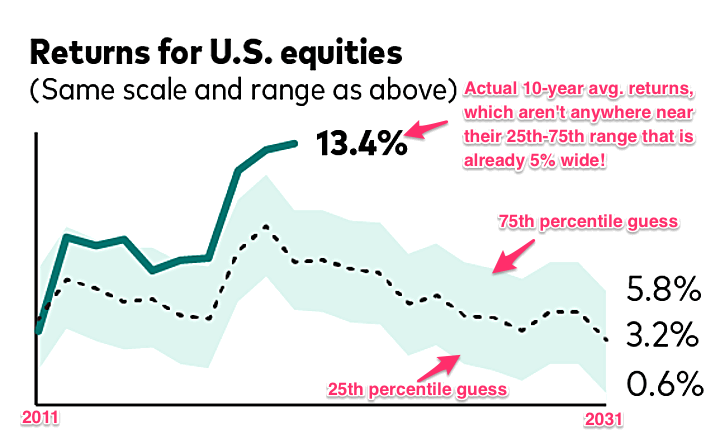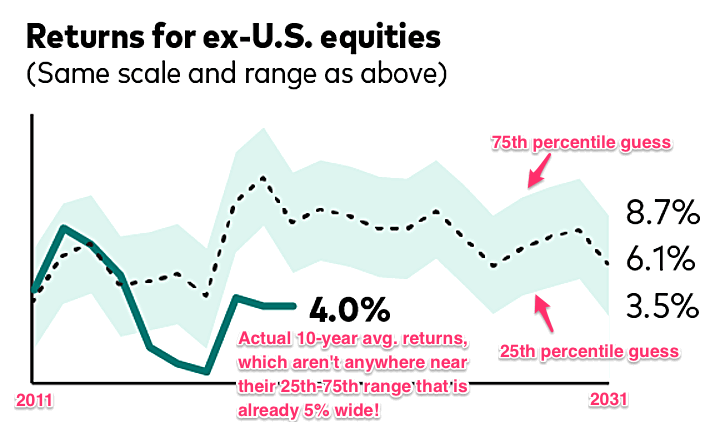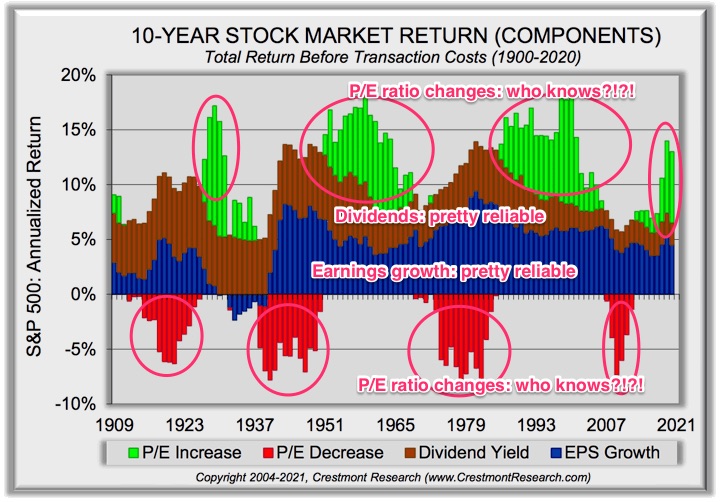Had been Vanguard’s 10-Yr Inventory Market Return Forecasts Correct? Or Actually Unsuitable? — My Cash Weblog

Periodically, Vanguard publishes asset class return forecasts for the subsequent 10 years. Right here is their most up-to-date one for September 2021. To their credit score, they’ve additionally printed a current follow-up submit monitoring each these forecasts alongside the precise returns looking back. It is a good lesson on the problem of any form of short-term market prediction, even after permitting your self 10 years and broad error bars.
Under is a chart monitoring their forecasts for the long run 10-year common annualized returns of US shares. Eyeballing their chart, for 2010-2020 their vary of confidence was someplace between roughly 5% and 10% yearly, for a median round 7.5%. This accounts for his or her mannequin’s twenty fifth percentile to seventy fifth proportion vary of doable outcomes. It is a fairly wide array! $100,000 occasions 5% annualized returns after 10 years is $163,000. $100,000 occasions 10% annualized returns after 10 years is $259,000.
Even accounting for that wide selection, their forecast for US shares was off. Whereas the curve appears vaguely comparable, US shares did considerably higher than their forecast:

Once more, even accounting for the large vary of guesses, their forecast for worldwide shares was additionally off. World non-US shares did considerably worse than their forecast:

Vanguard’s unique chart focuses on their 60/40 portfolio, which occurs to look so much higher. Why? Their 60/40 portfolio consists of 36% US equities, 24% international ex-US equities, 28% US bonds, and 12% ex-US bonds. For one, future bond returns are way more easy to foretell than inventory returns. Your present 10-year yield goes to be fairly near your eventual 10-year return. As well as, their US equities forecast was actually fallacious in a single path (too low), whereas their worldwide fairness forecast was fallacious within the different path (too excessive), in order that they tended to offset one another. Is that this diversification in motion? Definitely, sure, but additionally luck in my view. Each may have additionally been fallacious in the identical path.
Ought to we simply ignore these items utterly then? I preserve considering again to this illuminating chart evaluating the contributions of earnings development, dividends, and P/E ratio modifications to the full return of the S&P 500. Earnings development and dividends have been fairly constant for over 70 years, however the total swings in return have been principally attributable to P/E ratio growth and contraction.

Think about the analogy that P/E ratio growth and contraction behaves like a rubber band. It might probably stretch fairly far, a lot farther than you would possibly anticipate, however as you retain stretching it, the stronger it’ll ultimately wish to come again. However you by no means actually know the way far it could possibly stretch, or when it’ll snap again. Forecasts may be fallacious for a protracted, very long time. It’s a must to stability realizing that the run will finish ultimately, however not realizing when. Somebody will all the time be proper looking back.
If solely we may focus solely on the earnings development and dividends. These are what actually matter in the long term. That is the behavioral good thing about remembering that dividends are a share of income being distributed to you as a enterprise proprietor. Even when costs on a display are dropping, the companies are nonetheless working laborious, making income, reinvesting some for extra earnings development, and sending a few of it to you as money.


No comments